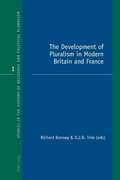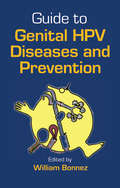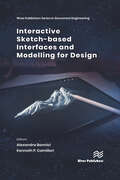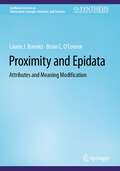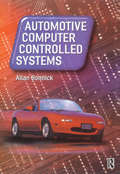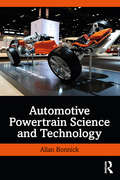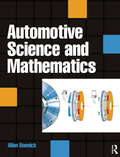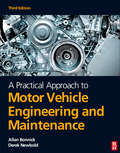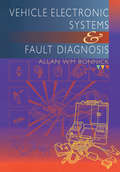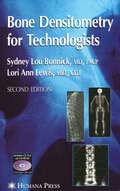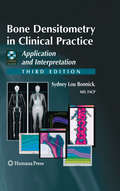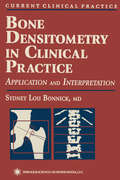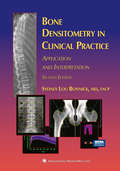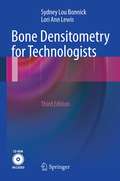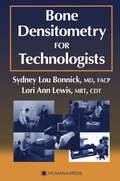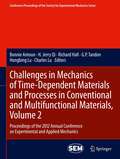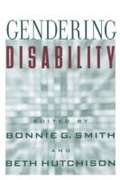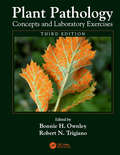- Table View
- List View
The Development Of Pluralism In Modern Britain And France (PDF)
by Richard J. Bonney David J. B. TrimEurope is increasingly multi-ethnic and multi-faith, as well as multi-cultural. Western democracies now comprise a plurality of fundamental opinions and inherited cultures; it is not clear how (or if!) they can be related to each other without involving either oppression or anarchy. This debate requires historical understanding and a contemporary grasp of the points at issue amongst different cultures. By virtue of their proximity and frequent historical interaction, Britain and France lend themselves to comparative study. The studies in this volume collectively demonstrate that the affairs of religious minorities in these two countries were not only of concern to themselves and their national established churches. Rather, over a long-term period, they had a sustained impact on many other issues. All chapters illustrate the problematic shift from a persecutory to a pluralistic mentality.
Guide to Genital HPV Diseases and Prevention: Diseases And Prevention
by William BonnezCustom-designed for clinicians on the frontline of treatment and prevention of the human papillomavirus (HPV), this stand-alone handbook provides the scientific background needed to understand and administer the new HPV vaccines. Written by some of the discoverers of these vaccines, this accessible text explores the biology and epidemiology of HPV,
Guide to Genital HPV Diseases and Prevention
by William BonnezCustom-designed for clinicians on the frontline of treatment and prevention of the human papillomavirus (HPV), this stand-alone handbook provides the scientific background needed to understand and administer the new HPV vaccines. Written by some of the discoverers of these vaccines, this accessible text explores the biology and epidemiology of HPV,
Interactive Sketch-based Interfaces and Modelling for Design
by Alexandra Bonnici Kenneth P. CamilleriSketching is a natural and intuitive communication tool used for expressing concepts and ideas that are difficult to communicate through text or speech alone. In design applications, drawings are used at various stages of the design process: from the early concept drawings scribbled on a piece of paper to immersive interactions in which users manipulate and adjust the 3D form of an object in virtual or augmented reality environments. This variety in drawing activities brings about the need for different interpretation strategies that support not only the sketching activity itself, but also allow sketch-based interactions, such as sketch-based queries, to take place. In this book, we explore the different drawing approaches used in design and the algorithms required for processing and interpreting the different sketches and drawings in design. The book is divided into two parts. The first part focuses on sketching in the 2D domain. This includes the digitization of offline and paperbased sketches, techniques for online sketch recognition, observations of user drawing habits, algorithms for inferring depth from 2D drawings, as well as non-photorealistic rendering techniques that are then applied to sketch-based queries. The second part of the book focuses on 3D sketching in virtual or augmented reality spaces. Here, we present the processing and rendering of the 3D strokes, the different interaction devices available for 3D sketching, and look at different applications where immersive 3D sketching has been applied with success.
Interactive Sketch-based Interfaces and Modelling for Design
by Alexandra Bonnici Kenneth P. CamilleriSketching is a natural and intuitive communication tool used for expressing concepts and ideas that are difficult to communicate through text or speech alone. In design applications, drawings are used at various stages of the design process: from the early concept drawings scribbled on a piece of paper to immersive interactions in which users manipulate and adjust the 3D form of an object in virtual or augmented reality environments. This variety in drawing activities brings about the need for different interpretation strategies that support not only the sketching activity itself, but also allow sketch-based interactions, such as sketch-based queries, to take place. In this book, we explore the different drawing approaches used in design and the algorithms required for processing and interpreting the different sketches and drawings in design. The book is divided into two parts. The first part focuses on sketching in the 2D domain. This includes the digitization of offline and paperbased sketches, techniques for online sketch recognition, observations of user drawing habits, algorithms for inferring depth from 2D drawings, as well as non-photorealistic rendering techniques that are then applied to sketch-based queries. The second part of the book focuses on 3D sketching in virtual or augmented reality spaces. Here, we present the processing and rendering of the 3D strokes, the different interaction devices available for 3D sketching, and look at different applications where immersive 3D sketching has been applied with success.
Proximity and Epidata: Attributes and Meaning Modification (Synthesis Lectures on Information Concepts, Retrieval, and Services)
by Laurie J. Bonnici Brian C. O'ConnorThis book provides a new model to explore discoverability and enhance the meaning of information. The authors have coined the term epidata, which includes items and circumstances that impact the expression of the data in a document, but are not part of the ordinary process of retrieval systems. Epidata affords pathways and points to details that cast light on proximities that might otherwise go unknown. In addition, epidata are clues to mis-and dis-information discernment. There are many ways to find needed information; however, finding the most useable information is not an easy task. The book explores the uses of proximity and the concept of epidata that increases the probability of finding functional information. The authors sketch a constellation of proximities, present examples of attempts to accomplish proximity, and provoke a discussion of the role of proximity in the field. In addition, the authors suggest that proximity is a thread between retrieval constructs based on known topics, predictable relations, and types of information seeking that lie outside constructs such as browsing, stumbling, encountering, detective work, art making, and translation.
Automotive Computer Controlled Systems
by Allan Bonnick'Automotive Computer Controlled Systems' explains the fundamental principles of engineering that lie behind the operation of vehicle electronic systems. Having obtained this knowledge, the reader will be able to make full use of the diagnostic equipment which is currently available. The book builds on the concepts contained in Vehicle Electronic Systems and Fault Diagnosis and gives clear steps to fault diagnosis and subsequent repair of the vehicle's electronic systems. The author discusses electronics only within the context of the vehicle systems under consideration, and thus keeps theory to a minimum.Allan Bonnick has written articles for several transport/vehicle journals and carries out consultancy work for the Institute of Road Transport Engineers. In addition, he has had many years teaching experience and is ideally placed to write this informative guide.
Automotive Computer Controlled Systems
by Allan Bonnick'Automotive Computer Controlled Systems' explains the fundamental principles of engineering that lie behind the operation of vehicle electronic systems. Having obtained this knowledge, the reader will be able to make full use of the diagnostic equipment which is currently available. The book builds on the concepts contained in Vehicle Electronic Systems and Fault Diagnosis and gives clear steps to fault diagnosis and subsequent repair of the vehicle's electronic systems. The author discusses electronics only within the context of the vehicle systems under consideration, and thus keeps theory to a minimum.Allan Bonnick has written articles for several transport/vehicle journals and carries out consultancy work for the Institute of Road Transport Engineers. In addition, he has had many years teaching experience and is ideally placed to write this informative guide.
Automotive Powertrain Science and Technology
by Allan BonnickA motor vehicle’s powertrain consists of the components which generate power and enable it to move – its engine, exhaust system, transmission, drive shaft, suspension and wheels. Any automotive engineering student going beyond basic mechanics will need a sound knowledge of the mathematics and scientific principles, particularly calculus and algebra, which underpin powertrain technology. This textbook supports a series of courses, for instance BTEC unit 28 “Further Mathematics for Engineering Technicians”, which is a requisite for a foundation degree in automotive engineering, and BTEC higher unit 25 “Engine and Vehicle Design and Performance”, without giving full coverage of automotive technology. It is a more focused companion to the author’s Automotive Science and Mathematics 978-0-7506-8522-1, also published by Routledge.
Automotive Powertrain Science and Technology
by Allan BonnickA motor vehicle’s powertrain consists of the components which generate power and enable it to move – its engine, exhaust system, transmission, drive shaft, suspension and wheels. Any automotive engineering student going beyond basic mechanics will need a sound knowledge of the mathematics and scientific principles, particularly calculus and algebra, which underpin powertrain technology. This textbook supports a series of courses, for instance BTEC unit 28 “Further Mathematics for Engineering Technicians”, which is a requisite for a foundation degree in automotive engineering, and BTEC higher unit 25 “Engine and Vehicle Design and Performance”, without giving full coverage of automotive technology. It is a more focused companion to the author’s Automotive Science and Mathematics 978-0-7506-8522-1, also published by Routledge.
Automotive Science and Mathematics
by Allan BonnickAutomotive technicians and students need a firm grasp of science and technology in order to fully appreciate and understand how mechanisms and systems of modern vehicles work. Automotive Science and Mathematics presents the necessary principles and applications with all the examples and exercises relating directly to motor vehicle technology and repair, making it easy for automotive students and apprentices to relate the theory back to their working practice.The coverage of this book is based on the syllabus requirements of the BTEC First in Vehicle Technology, BTEC National in Vehicle Repair and Technology, and the IMI Certificate and Diploma in Vehicle Maintenance and Repair, but will help all automotive students and apprentices at levels 2 and 3 and up to and including HNC/HND, foundation and first degree with their studies and in achieving the Key Skill 'Application of Number' at levels 2 and 3. The book is designed to cater for both light and heavy vehicle courses.Full worked solutions of most exercises are available as a free download for lecturers only from http://textbooks.elsevier.com.Allan Bonnick is a motor vehicle education and training consultant and was formerly Head of Motor Vehicle Engineering, Eastbourne College. He is the author of several established automotive engineering textbooks.
Automotive Science and Mathematics
by Allan BonnickAutomotive technicians and students need a firm grasp of science and technology in order to fully appreciate and understand how mechanisms and systems of modern vehicles work. Automotive Science and Mathematics presents the necessary principles and applications with all the examples and exercises relating directly to motor vehicle technology and repair, making it easy for automotive students and apprentices to relate the theory back to their working practice.The coverage of this book is based on the syllabus requirements of the BTEC First in Vehicle Technology, BTEC National in Vehicle Repair and Technology, and the IMI Certificate and Diploma in Vehicle Maintenance and Repair, but will help all automotive students and apprentices at levels 2 and 3 and up to and including HNC/HND, foundation and first degree with their studies and in achieving the Key Skill 'Application of Number' at levels 2 and 3. The book is designed to cater for both light and heavy vehicle courses.Full worked solutions of most exercises are available as a free download for lecturers only from http://textbooks.elsevier.com.Allan Bonnick is a motor vehicle education and training consultant and was formerly Head of Motor Vehicle Engineering, Eastbourne College. He is the author of several established automotive engineering textbooks.
A Practical Approach to Motor Vehicle Engineering and Maintenance
by Allan BonnickFully updated and in line with latest specifications, this textbook integrates vehicle maintenance procedures, making it the indispensable first classroom and workshop text for all students of motor vehicle engineering, apprentices and keen amateurs. Its clear, logical approach, excellent illustrations and step-by-step development of theory and practice make this an accessible text for students of all abilities.With this book, students have information that they can trust because it is written by an experienced practitioner and lecturer in this area. This book will provide not only the information required to understand automotive engines but also background information that allows readers to put this information into context.The book contains flowcharts, diagnostic case studies, detailed diagrams of how systems operate and overview descriptions of how systems work. All this on top of step-by-step instructions and quick reference tables. Readers won't get bored when working through this book with questions and answers that aid learning and revision included.
A Practical Approach to Motor Vehicle Engineering and Maintenance
by Allan BonnickFully updated and in line with latest specifications, this textbook integrates vehicle maintenance procedures, making it the indispensable first classroom and workshop text for all students of motor vehicle engineering, apprentices and keen amateurs. Its clear, logical approach, excellent illustrations and step-by-step development of theory and practice make this an accessible text for students of all abilities.With this book, students have information that they can trust because it is written by an experienced practitioner and lecturer in this area. This book will provide not only the information required to understand automotive engines but also background information that allows readers to put this information into context.The book contains flowcharts, diagnostic case studies, detailed diagrams of how systems operate and overview descriptions of how systems work. All this on top of step-by-step instructions and quick reference tables. Readers won't get bored when working through this book with questions and answers that aid learning and revision included.
Vehicle Electronic Systems and Fault Diagnosis
by Allan BonnickThe average car now contains much more electronic circuitry than would have been the case, even five years ago. This leaves many technicians struggling to keep up with current developments in the repair and maintenance of these electronic systems. Often, texts covering vehicle electronics dwell on unnecessary maths and general electronics principles. This practical guide discusses electronics ony within the context of the vehicle system under consideration and thus keeps theory to a minimum. Using numerous diagrams, photographs and step by step instructions, this book gives a clear description of vehicle electronic systems and fault diagnosos and than continues on to the testing and repair of these systems. Regular reviews and summaries help consolidate learning and make this book ideal for workshop and classroom use.
Vehicle Electronic Systems and Fault Diagnosis
by Allan BonnickThe average car now contains much more electronic circuitry than would have been the case, even five years ago. This leaves many technicians struggling to keep up with current developments in the repair and maintenance of these electronic systems. Often, texts covering vehicle electronics dwell on unnecessary maths and general electronics principles. This practical guide discusses electronics ony within the context of the vehicle system under consideration and thus keeps theory to a minimum. Using numerous diagrams, photographs and step by step instructions, this book gives a clear description of vehicle electronic systems and fault diagnosos and than continues on to the testing and repair of these systems. Regular reviews and summaries help consolidate learning and make this book ideal for workshop and classroom use.
Bone Densitometry for Technologists
by Sydney Lou BonnickSydney Lou Bonnick, MD, FACP, and Lori Ann Lewis, MRT, CDT, have updated and expanded their highly praised Bone Densitometry for Technologists to reflect the latest standards and developments in the field. Here radiologic technologists, nurse practitioners, physician assistants, and dedicated densitometry technologists can find new guidelines for bone density testing, new therapies for osteoporosis, and new treatment guidelines for osteoporosis, as well as new chapters on pediatric densitometry, body composition assessments, and the use of skeletal morphometry in diagnosis and fracture risk prediction.
Bone Densitometry in Clinical Practice: Application and Interpretation (Current Clinical Practice)
by Sydney Lou BonnickBone densitometry (BD) is an extraordinary clinical tool. It provides a safe, non-invasive window to the skeleton. Through that window, a physician can obtain vital clinical information that enhances diagnosis and improves patient management. Further, much has changed in the last decade to make bone densitometry the especially fascinating field of medicine it is today, incorporating imaging, physics, quantitative analysis, statistics, and computer technology -- all applied in the diagnosis and management of osteoporosis.No text details the state-of-the-art and value of densitometry better than Bone Densitometry in Clinical Practice: Applications and Interpretation, Third Edition. Written by renowned expert Sydney Lou Bonnick, MD, this edition improves remarkably on her highly regarded previous volumes, with a significant update and expansion of material. New chapters reflect densitometry’s growing applications as well as the evolving needs of the densitometrist. New material on radiation safety and assessment for secondary causes of bone fragility is included, and the text also incorporates material from the recent ISCD Position Development Conferences (PDC’s), both the 4th adult and the 1st pediatric. Moreover, an entire appendix devoted to the PDCs has been added, providing solutions to many unanswered questions concerning bone densitometry applications.Comprehensive and invaluable, Bone Densitometry in Clinical Practice: Application and Interpretation, Third Edition offers all primary care physicians and specialists the ideal reference for practicing state-of-the-art bone densitometry and caring for patients with, or at risk for, osteoporosis.
Bone Densitometry in Clinical Practice: Application And Interpretation (Current Clinical Practice)
by Sydney Lou BonnickPrecision and accuracy are terms that are used in quantitative scientific fields to describe the reproducibility of a measurement or the capacity of a measurement to quantify the actual biological matter present. Precision and accuracy are also important applications in the quality control and quality assurance of the performance and interpretation of bone mass measure ments. Precision and accuracy also reflect the values and qualities of the author of this important text in the clinical application of bone densitometry. This is the first textbook of its kind devoted entirely to the proper use of this technology in the practice of medicine. Dr. Sydney L. Bonnick has devoted a majority of her career helping to define excellence in this exploding area and in doing so, has earned the respect and admiration of the international bone densitometry community. Confusion abounds in this field due to the proliferation of bone densito metry devices, including the various models that can measure many skel etal sites, the different normative data bases used, and the establishment of diagnostic categories of low bone mass. Dr. Bonnick's authoritative and carefully referenced text will certainly clarify and broaden the knowledge of those physicians who currently perform bone densitometry. This text is designed to be utilized by a wide range of medical specialists: endocrinolo gists, rheumatologists, gynecologists, radiologists, orthopedic surgeons, and nephrologists.
Bone Densitometry in Clinical Practice: Application and Interpretation (Current Clinical Practice)
by Sydney Lou BonnickThe second edition of Dr. Sydney Lou Bonnick’s text Bone Densitometry in Clinical Practice is an expansion of her highly regarded first edition, which has provided the bone densitometry community with simply the best, most accurate, and most precisely written resource in our field. Dr. Bonnick has applied her very careful and exact scientific approaches to expand and improve on her widely regarded initial text. In addition to the chapters in the first edition on the science of bone densitometry and its clinical appli- tion, this text has new chapters and a CD-ROM that come at a very critical time in our field. The clinical use of bone densitometry is increasing exponentially as more professional societies have endorsements and guidelines on the application of bone densitometry in the assessment and management of osteoporosis. The recent endorsement of population screening by the US Preventive Services Task Force (USPSTF) has now provided g- ernmental validation to this technology, whose proper use Dr. Bonnick has pioneered. In a new chapter, Dr. Bonnick compares the similarities and differences in the recent gui- lines from the USPSTF and the National Osteoporosis Foundation, American Assoc- tion of Clinical Endocrinologists, American College of Obstetrics and Gynecology, and the North American Menopause Society.
Bone Densitometry for Technologists
by Sydney Lou Bonnick Lori Ann LewisAs a technology, bone densitometry is really quite extraordinary. The ability to quantify the density of the bones at a variety of skeletal sites has truly revolutionized the approach to a number of diseases, the most important of which is osteoporosis. Using the information from the machines, especially dual-energy X ray absortiometry (DXA) technology, physicians can recommend and prescribe interventions that will slow bone loss and reduce the risk of disabling fractures. The remarkable advances in skeletal imaging with densitometry devices have made possible quantitative and diagnostic assessments of skeletal structure. However it is in fact the skill and concern of the technologist that enables all of this to happen. In this updated and expanded third edition of their gold standard and highly praised Bone Densitometry for Technologists, Sydney Lou Bonnick, MD, FACP, and Lori Ann Lewis, MRT, CDT, again offer the most comprehensive review of the standards and developments in the field. Here radiologic technologists, nurse practitioners, physician assistants, and dedicated densitometry technologists can find not only the state-of-the-art guidelines for bone density testing, but also a wide range of other topics, including several new chapters. These include a new chapter on the performance of DXA lumbar spine, proximal femur and forearm studies; one on Using Absolute Risk to Predict Fracture Risk in Clinical Practice; and another providing examples of highly instructional DXA images in which artifacts or structural changes can be seen. There are 2 new appendices and the other 10 appendices from the previous edition have been updated wherever necessary to reflect the most current information available. In Appendix XII, the contents of the accompanying CD-ROM are reviewed. On this CD, readers will find the Precision Calculator Companion that was first included with the 2nd edition of Dr. Bonnick’s title, Bone Densitometry in Clinical Practice. Questionnaires designed to capture essential information to utilize FRAX for both men and women are also included on the CD. These questionnaires can be persomalized to better suit a practice's needs. Finally, a continuing education review is also found on the CD, which, if successfully completed, will result in the awarding of 16 hours of Category A credit acceptable to the American Society of Radiologic Technologists.
Bone Densitometry for Technologists
by Sydney Lou Bonnick Lori Ann LewisIn Bone Densitometry for Technologists, leading densitometry experts Sydney Lou Bonnick, MD, FACP, and Lori Ann Lewis, MRT, CDT, review in simple language all the essentials of densitometry to help practicing radiologic technologists, nurse practitioners, and physician assistants expertly operate any of today's sophisticated densitometry machines. Topics range from technical descriptions of all FDA-approved densitometry devices to a clinical review of osteoporosis, and include comprehensive tutorials on computer basics, anatomy for densitometrists, the art of interpreting test results, and performing successful precision studies-all crafted to meet the daily needs of the practicing densitometrist. Comprehensive, informative, and highly practical, Bone Densitometry for Technologists is the technologist's "bible" of densitometry.
Challenges in Mechanics of Time-Dependent Materials and Processes in Conventional and Multifunctional Materials, Volume 2: Proceedings of the 2012 Annual Conference on Experimental and Applied Mechanics (Conference Proceedings of the Society for Experimental Mechanics Series #37)
by Bonnie Antoun, H. Jerry Qi, Richard Hall, G.P. Tandon, Hongbing Lu and Charles LuChallenges in Mechanics of Time-Dependent Materials and Processes in Conventional and Multifunctional Materials, Volume 2 represents one of seven volumes of technical papers presented at the Society for Experimental Mechanics SEM 12th International Congress & Exposition on Experimental and Applied Mechanics, held at Costa Mesa, California, June 11-14, 2012. The full set of proceedings also includes volumes on: Dynamic Behavior of Materials, Imaging Methods for Novel Materials and Challenging Applications, Experimental and Applied Mechanics, 2nd International Symposium on the Mechanics of Biological Systems and Materials 13th International Symposium on MEMS and Nanotechnology and, Composite Materials and the 1st International Symposium on Joining Technologies for Composites.
Gendering Disability
by Bonnie G. Smith (Editor Contribution By Allison Kafer Carol Kaufman-Scarborough Georgina Kleege Thilo Kroll Catherine J. Kudlick Kristin Lindgren Melissa J. Mcneil Corbett Joan O'Toole Lisa Schur Russell P. Shuttleworth Beth Hutchison Daniel J. Wilson Adrienne Asch Brenda Jo Brueggemann Rosemarie Garland-Thomson Robin Adele Greeley Sarah E. Chinn Sumi Colligan Ann M. FoxDisability and gender, terms that have previously seemed so clear-cut, are becoming increasingly complex in light of new politics and scholarship. These words now suggest complicated sets of practices and ways of being. Contributors to this innovative collection explore the intersection of gender and disability in the arts, consumer culture, healing, the personal and private realms, and the appearance of disability in the public sphere--both in public fantasies and in public activism. Beginning as separate enterprises that followed activist and scholarly paths, gender and disability studies have reached a point where they can move beyond their boundaries for a common landscape to inspire new areas of inquiry. Whether from a perspective in the humanities, social sciences, sciences, or arts, the shared subject matter of gender and disability studies--the body, social and cultural hierarchy, identity, discrimination and inequality, representation, and political activism--insistently calls for deeper conversation. This volume provides fresh findings not only about the discrimination practiced against women and people with disabilities, but also about the productive parallelism between these two categories.
Plant Pathology Concepts and Laboratory Exercises: Concepts And Laboratory Exercises
by Bonnie H. Ownley and Robert N. TrigianoContinuing in the tradition of its predecessors, this new edition combines an informal, easy to read style with a thorough introduction to concepts and terminology of plant pathology. After reviewing fundamental concepts, the book discusses groups of plant pathogens and molecular tools for studying them, pathogen interactions, epidemiology and disease control, and special topics in plant pathology. The book details various disease-causing organisms, including viruses, fungi, prokaryotics, nematodes, and various biotic agents. It also examines various plant-pathogen interactions, molecular attack strategies, extracellular enzymes, host defenses, and disruption of plant function. New in the Third Edition Molecular plant-fungal interactions Expanded treatment of molecular tools Advanced biocontrol concepts How to use and care for microscopes
